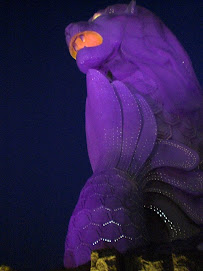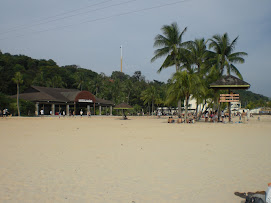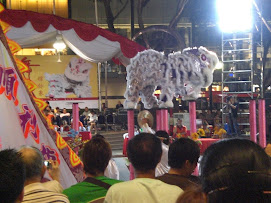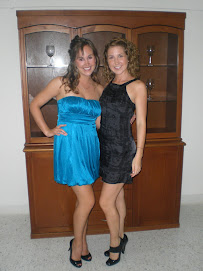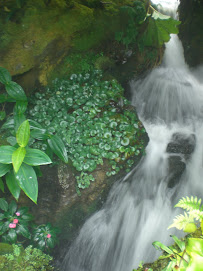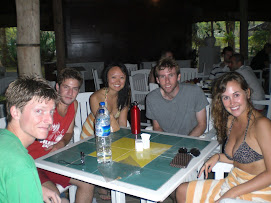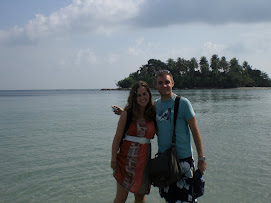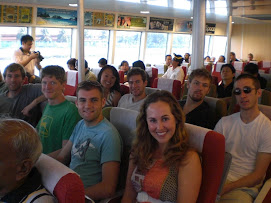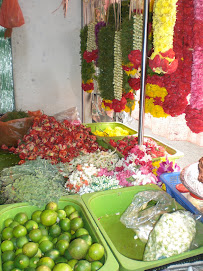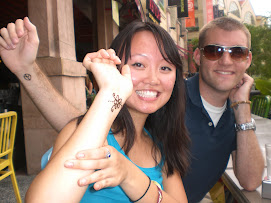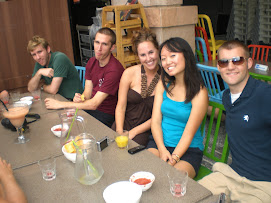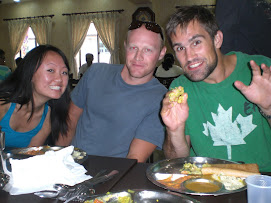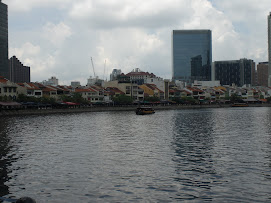.JPG) When you are walking amidst a ‘crop’ of dragon fruit-producing cacti in Thailand and the little Thai woman who mothers the plants walks out of her home, plucks one of the pink pearls from the tree, peels back the skin, and offers you a taste of the delicate, creamy, pink pulp fresh from the vine, your life feels a bit surreal already. But when the same, weathered, non-English speaking Thai woman proceeds to grab hold of your hand and continues to maintain the grasp with a vice-like grip that could only belong to a person who has spent much of her life working with her hands, your life feels downright dreamlike. Yet, it wasn’t a dream.
When you are walking amidst a ‘crop’ of dragon fruit-producing cacti in Thailand and the little Thai woman who mothers the plants walks out of her home, plucks one of the pink pearls from the tree, peels back the skin, and offers you a taste of the delicate, creamy, pink pulp fresh from the vine, your life feels a bit surreal already. But when the same, weathered, non-English speaking Thai woman proceeds to grab hold of your hand and continues to maintain the grasp with a vice-like grip that could only belong to a person who has spent much of her life working with her hands, your life feels downright dreamlike. Yet, it wasn’t a dream. .JPG) Tim and I had been in Krabi, Thailand for less than six hours when our guide made a pit stop at a beautiful, colonial-style home complete with an iron gate, wooden porch swing, ivy archway, and dragon fruit orchard. We were coming from a morning spent exploring the sea caves of Krabi via kayak, after which we had enjoyed a local food feast in a floating restaurant near our dock. Turns out, a casual mention to your Thai guide about your love for local fruits can bring you to a pit stop at a dragon fruit farm in someone’s back yard. Who knew?
Tim and I had been in Krabi, Thailand for less than six hours when our guide made a pit stop at a beautiful, colonial-style home complete with an iron gate, wooden porch swing, ivy archway, and dragon fruit orchard. We were coming from a morning spent exploring the sea caves of Krabi via kayak, after which we had enjoyed a local food feast in a floating restaurant near our dock. Turns out, a casual mention to your Thai guide about your love for local fruits can bring you to a pit stop at a dragon fruit farm in someone’s back yard. Who knew?
 I was delighted by the strange way the dragon fruits appear, almost like a tumorous growth, at the tip of the cactus’ arms. I couldn’t help but smile and laugh with the chubby Thai boys playing some strange only-little-boys-know-what-the-object-of-this-is game with sticks and a cactus at the back of the rows of plants. I found pure bliss in sampling one of the sweet-sour pink pitaya. And I was utterly contented to have Tim so close to me sharing such a serendipitous travel-in-Southeast-Asia moment. All of these factors added to a feeling of true blue gut-happiness. But, it was one of the simplest of all human gestures that forced this happiness up to touch my heart as well.
I was delighted by the strange way the dragon fruits appear, almost like a tumorous growth, at the tip of the cactus’ arms. I couldn’t help but smile and laugh with the chubby Thai boys playing some strange only-little-boys-know-what-the-object-of-this-is game with sticks and a cactus at the back of the rows of plants. I found pure bliss in sampling one of the sweet-sour pink pitaya. And I was utterly contented to have Tim so close to me sharing such a serendipitous travel-in-Southeast-Asia moment. All of these factors added to a feeling of true blue gut-happiness. But, it was one of the simplest of all human gestures that forced this happiness up to touch my heart as well.The Thai woman’s desire to hold my hand related a common human desire to feel connected with others. Without the ability to interact through language, her vice-like grip felt like desperation to communicate an appreciation for visitors. And her initial unwillingness to let go, felt like the most genuine offer of thanks I have ever received.
 Tim and I went on to have one of those once-in-a-lifetime kind of memorable days, swinging from ropes into a freshwater pond dotted with lilies, watching the sun set over a nearly deserted shell-sand beach, and savoring a slow, mouth-watering Thai curry dinner while watching the World Cup. Yet, it is our quiet moment with the little Thai woman at the dragon fruit farm which seems seared most clearly in my memory.
Tim and I went on to have one of those once-in-a-lifetime kind of memorable days, swinging from ropes into a freshwater pond dotted with lilies, watching the sun set over a nearly deserted shell-sand beach, and savoring a slow, mouth-watering Thai curry dinner while watching the World Cup. Yet, it is our quiet moment with the little Thai woman at the dragon fruit farm which seems seared most clearly in my memory.


.JPG) In China the dragon is a symbol of strength, power, and, in contrast to the European dragon, benevolence. So, how nice to find these commendable qualities in a two-minute, language-free connection with a dragon-fruit farming Thai woman.
In China the dragon is a symbol of strength, power, and, in contrast to the European dragon, benevolence. So, how nice to find these commendable qualities in a two-minute, language-free connection with a dragon-fruit farming Thai woman..JPG)
Six down…two to go.
xoxo,
Rachel


 And while these dances are worlds away from my day-to-day knowledge, I cannot help but realize how much I was able to relate and connect to them. After all, what is more raw and purely human than poverty-stricken orphans, singing and moving with a joy so innocent and pure that it can only be found as glints in the eyes of children all over the world? Who cannot relate to the heavy weight of grander which presses on one’s chest at the sight of a great and beautiful performance hall or theatre? And what cultural, ethnic, religious, political, or economic barrier stands in the way of the themes of young love, daily chores, and prayer/spirituality which weaved themselves into the traditional Khmer dances?
And while these dances are worlds away from my day-to-day knowledge, I cannot help but realize how much I was able to relate and connect to them. After all, what is more raw and purely human than poverty-stricken orphans, singing and moving with a joy so innocent and pure that it can only be found as glints in the eyes of children all over the world? Who cannot relate to the heavy weight of grander which presses on one’s chest at the sight of a great and beautiful performance hall or theatre? And what cultural, ethnic, religious, political, or economic barrier stands in the way of the themes of young love, daily chores, and prayer/spirituality which weaved themselves into the traditional Khmer dances?



 Then, with a hearty breakfast under our belts the following morning, we boarded the infamous bus for the soon-to-be long journey to
Then, with a hearty breakfast under our belts the following morning, we boarded the infamous bus for the soon-to-be long journey to  After our arrival, we were quite ready for a lovely dinner at the Red Piano restaurant on Pub Street and a massage at our hotel, thanks to the lack of shocks in the aforementioned bus. Welcome to Cambodia Mom and Sis.
After our arrival, we were quite ready for a lovely dinner at the Red Piano restaurant on Pub Street and a massage at our hotel, thanks to the lack of shocks in the aforementioned bus. Welcome to Cambodia Mom and Sis. 
 Four down…four to go.
Four down…four to go.
 The ‘sandwiches’ are made with
The ‘sandwiches’ are made with  While
While 
 After hearing all about the positive health affects of beer on a Tiger Brewery tour with my dad and grandma, I was curious to try this ‘healthy’ green tonic. If regular beer can, according to our expert Tiger tour guide, raise the levels of good cholesterol thus keeping the arteries free of dangerous build-up, give one a boost of vitamins B1, B2, B3, and B6, help to calm and relax the nerves before bed, and improve performance, concentration, and reaction time in athletes, then a beer chock-full of vegetable protein, beta-carotene, essential fatty acids, and Vitamin B12 must be nothing short of bottled health. (Dad, you can thank me later for relaying this information to Mom.)
After hearing all about the positive health affects of beer on a Tiger Brewery tour with my dad and grandma, I was curious to try this ‘healthy’ green tonic. If regular beer can, according to our expert Tiger tour guide, raise the levels of good cholesterol thus keeping the arteries free of dangerous build-up, give one a boost of vitamins B1, B2, B3, and B6, help to calm and relax the nerves before bed, and improve performance, concentration, and reaction time in athletes, then a beer chock-full of vegetable protein, beta-carotene, essential fatty acids, and Vitamin B12 must be nothing short of bottled health. (Dad, you can thank me later for relaying this information to Mom.)
 So, Tim and I gave the green, liquid, vitamin concoction a try.
So, Tim and I gave the green, liquid, vitamin concoction a try.  The color green may get a bad rap; it is the color of jealousy, mold, and roller-coaster-induced nausea after all. However, I have found a strange sort-of joy in all things green this month. Here’s to going green.
The color green may get a bad rap; it is the color of jealousy, mold, and roller-coaster-induced nausea after all. However, I have found a strange sort-of joy in all things green this month. Here’s to going green.
 In Beijing, I sat on a bench near Tiananmen Square for nearly 30 minutes as people lined up to capture a moment on film with me, and several not-so-covert Japanese photographers took my photo on both my trips to Angkor Wat in Cambodia. (As a side note, I’d be interested to hear what they tell their family and friends when they are going through their vacation photos. “Oh, this is the random white girl I took my photo with.” I wonder if I’ll make it to someone’s mantelpiece or blog someday?)
In Beijing, I sat on a bench near Tiananmen Square for nearly 30 minutes as people lined up to capture a moment on film with me, and several not-so-covert Japanese photographers took my photo on both my trips to Angkor Wat in Cambodia. (As a side note, I’d be interested to hear what they tell their family and friends when they are going through their vacation photos. “Oh, this is the random white girl I took my photo with.” I wonder if I’ll make it to someone’s mantelpiece or blog someday?)
 So, of course, my sister, mother, and grandmother were no exception to the novelty rule throughout their visit in Asia. They were good sports when the large group of Indian men requested a photo shoot at Sentosa and graciously accepted every compliment they received about their beauty from everyone from my Vice Principal to the street children and masseuses in Cambodia.
So, of course, my sister, mother, and grandmother were no exception to the novelty rule throughout their visit in Asia. They were good sports when the large group of Indian men requested a photo shoot at Sentosa and graciously accepted every compliment they received about their beauty from everyone from my Vice Principal to the street children and masseuses in Cambodia. Tim was not spared the ego-stroking power of the rule of novelty either. After he paid an afternoon visit to my school, the rumor running ramped among not only the students but also my colleagues was that Ms. Rachel is dating a David Beckham or Justin Timberlake look-a-like. In addition, the lady at my regular nail salon gave me a thumbs-up sign and mouthed the words “very handsome” behind Tim’s back as he was waiting for his massage. I am oh so glad the lady at the nail salon approves of my taste in men. Thanks.
Tim was not spared the ego-stroking power of the rule of novelty either. After he paid an afternoon visit to my school, the rumor running ramped among not only the students but also my colleagues was that Ms. Rachel is dating a David Beckham or Justin Timberlake look-a-like. In addition, the lady at my regular nail salon gave me a thumbs-up sign and mouthed the words “very handsome” behind Tim’s back as he was waiting for his massage. I am oh so glad the lady at the nail salon approves of my taste in men. Thanks.
 So being that the Flyer is said to encompass so much luck, not to mention it is one of the “Top 10 in Singapore”, I naturally visited the Flyer with both my family and Tim when they were here on their respective vacations.
So being that the Flyer is said to encompass so much luck, not to mention it is one of the “Top 10 in Singapore”, I naturally visited the Flyer with both my family and Tim when they were here on their respective vacations.

 In addition, being that the number eight is on my mind, not to mention I have not put up a blog entry in almost two months and a lot has happened between then and now, I have set a personal goal for myself. For the next EIGHT days I will write one blog entry a day, totaling, of course, EIGHT. Each of the EIGHT entries will include highlights and anecdotes about my family’s visit to Singapore and our trip to Cambodia or Tim’s trip which included vacations to both Thailand and Malaysia.
In addition, being that the number eight is on my mind, not to mention I have not put up a blog entry in almost two months and a lot has happened between then and now, I have set a personal goal for myself. For the next EIGHT days I will write one blog entry a day, totaling, of course, EIGHT. Each of the EIGHT entries will include highlights and anecdotes about my family’s visit to Singapore and our trip to Cambodia or Tim’s trip which included vacations to both Thailand and Malaysia.
